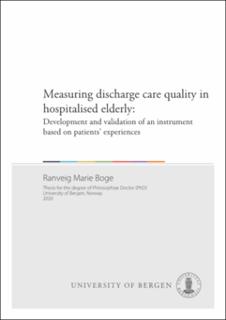| dc.contributor.author | Boge, Ranveig Marie | en_US |
| dc.date.accessioned | 2020-04-08T06:07:29Z | |
| dc.date.available | 2020-04-08T06:07:29Z | |
| dc.date.issued | 2020-03-20 | |
| dc.date.submitted | 2020-02-25T10:59:13.535Z | |
| dc.identifier | container/95/ef/2d/ac/95ef2dac-54ce-404a-b32a-a3d1a291a53b | |
| dc.identifier.isbn | 9788230849705 | en_US |
| dc.identifier.isbn | 9788230856376 | en_US |
| dc.identifier.uri | https://hdl.handle.net/1956/21805 | |
| dc.description.abstract | Background: Elderly patients account for a majority of hospital admissions. Their wellbeing and safety are at risk in the discharge process due to quality deficiencies, thus, accurate and vigorous instruments to monitor quality in discharge care are important. Further, use of patient experience data to target improvement work and research constitute a basis for quality indicators. A review of literature reveals that validated instruments aimed at measuring quality of hospital discharge from the perspective of elderly patients are currently lacking. Aim and objectives: The overall aim of this study was to develop a feasible and brief survey instrument for measuring the quality of care based on elderly patients’ experiences with hospital discharge and self-care after hospitalisation. The objectives were twofold: to examine the psychometric properties and validate the instrument, and to investigate a clinical application of the instrument. Methods: We conducted two studies using a cross-sectional design, including patients aged 65 years and older. In Study 1, a total of 419 patients discharged from one orthopaedic and five medical wards at Haukeland University Hospital were included. Study 2 included 1,418 patients from two medical wards at Haukeland University Hospital and Haraldsplass Deaconess Hospital. Both studies gathered data through a paper-based survey that was distributed approximately one month after discharge. A systematic literature search identified 16 candidate-items of the Discharge Care Experiences Survey Modified (DICARES-M). Intraclass correlation between the items was examined for consistencies in the test re-test measure. Factors analysis was applied to identify and validate the factor structures of the internal reliability consistency of the instrument. For the purpose of external validation, the final DICARES-M was correlated to scores from the Nordic Patient Experiences Questionnaire, the 12-Item Short-Form Health Survey, Subjective Health Complaints, and the quality indicator emergency readmission (i.e. emergency readmission within 30 days after discharge). To test the recognised three-factor structure of the DICARES-M more rigorously, we applied confirmatory factor analysis. A subset of experience data from Study 2 was analysed to measure the association between the discharge conversation and discharge quality. The association between the usefulness of the discharge conversation and the scores on the quality indicators DICARES-M and NORPEQ were evaluated. Results: A total of 270 (64%) patients completed the survey in Study 1 (Paper I). The mean age of the patients were 77 years (SD=7) and 58% were men. The factor analysis showed a 10-item, three factor instrument explaining 64% of the total variance. The Cronbach’s α for the three factors were acceptable (≥70). The overall intraclass correlation was 0.76. A moderate Spearman correlation was found between the total mean DICARES-M score and the total mean score of the Nordic Patient Experiences Questionnaire (rho = 0.54, P <0.01). An inversely association was found between the total mean DICARES-M score and emergency readmission. Totally, 493 patients (35%) responded to Study 2 (Paper II), with a mean age of 79 years (SD=8), and 52% were women. Confirmatory factor analysis revealed acceptable model fit. Cronbach’s α for the three factors were 0.82, 0.71 and 0.66. A moderate correlation was found between DICARES-M the Nordic Patient Experiences Questionnaire (rho = 0.49, P < 0.001). Higher overall DICARES-M scores, indicating more positive experiences, were found for patients with no emergency readmissions compared to patients who were emergency readmitted within 30 days (P < 0.001). In all, 487 (34%) patients were included in Study 2 (Paper III). Patients who reported having a discharge conversation (74%) scored higher on DICARES-M and NORPEQ compared to those who did not have this conversation (15%). Patients who considered the conversation more useful scored significantly higher to DICARES-M and NORPEQ (P < 0.001). Conclusions: We have developed survey instrument feasible of assessing patients’ experiences with discharge and self-care after hospitalisation and thereby may have established an indicator of quality in the discharge process. DICARES-M has demonstrated satisfactory psychometric properties, further; it appears to capture the quality care of the discharge process sensitively in terms of emergency readmission and independently in terms of patient comorbidity. Thus, we suggest DICARES-M as an additional instrument in improvement work of discharge care in elderly patients. An application of the instrument showed a significant association between discharge conversation and discharge quality, where higher scores on reported usefulness of the conversation were positively associated with patients’ experience. | en_US |
| dc.language.iso | eng | eng |
| dc.publisher | The University of Bergen | eng |
| dc.relation.haspart | Paper I: Boge RM, Haugen AS, Nilsen RM, Harthug S. Elderly patients' (≥65 years) experiences associated with discharge; Development, validity and reliability of the Discharge Care Experiences Survey. PLoS One, 2018. 13(11): e0206904. The article is available at: <a href="http://hdl.handle.net/1956/19259" target="blank">http://hdl.handle.net/1956/19259</a> | en_US |
| dc.relation.haspart | Paper II: Boge RM, Haugen AS, Nilsen RM, Bruvik F, Harthug S. Discharge care quality in hospitalised elderly patients: Extended validation of the Discharge Care Experiences Survey. PLoS One, 2019. 14(9): e0223150. The article is available at: <a href="http://hdl.handle.net/1956/21803" target="blank">http://hdl.handle.net/1956/21803</a> | en_US |
| dc.relation.haspart | Paper III: Boge RM, Haugen AS, Nilsen RM, Bruvik F, Harthug S. Measuring discharge quality based on elderly patients’ experiences with discharge conversation: a cross-sectional study. BMJ Open Quality. 2019. 8:e000728. The article is available at: <a href="http://hdl.handle.net/1956/21804" target="blank">http://hdl.handle.net/1956/21804</a> | en_US |
| dc.rights | In copyright | eng |
| dc.rights.uri | http://rightsstatements.org/page/InC/1.0/ | eng |
| dc.title | Measuring discharge care quality in hospitalised elderly: Development and validation of an instrument based on patients’ experiences | en_US |
| dc.type | Doctoral thesis | |
| dc.date.updated | 2020-02-25T10:59:13.535Z | |
| dc.rights.holder | Copyright the Author. All rights reserved | |
| fs.unitcode | 13-25-0 | |
